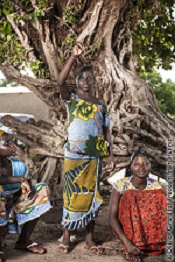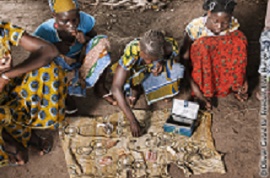A Bridge to Adulthood: The Promise of Savings Groups for Vulnerable Children
Image

The precarious transition from childhood to adulthood
Young people face increasing responsibilities yet, at the same time, they have limited access to financial resources and opportunities. Their limited resources in the face of these increasing responsibilities make them vulnerable to shocks. For children who are already vulnerable—for example, children who are orphaned or separated from their parents due to HIV or AIDS—the precariousness of this transitional period is even greater. They may be at a higher risk than their peers of experiencing barriers to health care access, low school enrollment, or neglect vis-à-vis other children in the household.

Financial services helping young people make the transition
While the transitional period between childhood and adulthood is rife with risk, it also presents an opportunity to build the habits, skills, and assets that carry over into young people’s adult lives. With our Advancing Integrated Microfinance for Youth (AIM Youth) initiative, Freedom from Hunger had the opportunity to test different models of integrated financial services and financial education to help young people successfully navigate this precarious transition.
Working with partners in Ecuador and Mali, we designed and tested three different models for delivering financial services—primarily savings—and education to young people 13–24 years old:
- Individual savings accounts at formal financial institutions and financial education delivered primarily through schools
- Group savings accounts at formal financial institutions and delivery of financial education at group meetings
- Youth savings groups facilitated by non-governmental organizations (NGOs) with financial education delivered at group meetings
In Ecuador, we worked with four credit unions to design individual savings accounts with low or no opening fees, no maintenance fees, and remote-deposit capability. Credit union staff facilitated financial education sessions in schools and promoted voluntary uptake of the individual saving accounts. While we saw some improvements in savings habits of youth participating in the financial education, not all participating youth opened individual saving accounts. Instead, other youth—primarily over 18 years of age and not participating in the financial education—opened the individual saving accounts.
In Mali, we worked with a credit union federation to design a group savings account, where members were able to share the costs and requirements for account opening. Credit union staff formed groups of youth from vocational centers, supported group formation account opening, and delivered financial education sessions. With this approach, group members increased their total savings but did not show improvement in financial knowledge since levels were quite high from the start—perhaps as a result of attracting older youth with greater experience with financial services.

In Mali, we also worked with two local NGOs to adapt a savings-led approach. In this approach, which had initially been designed for adult women, both male and female youth self-selected for either single- or mixed-gender groups. In these groups, members came together to save regularly on a voluntary basis while following a set of group-defined norms. Field staff of the local NGOs formed the savings groups and also facilitated the financial education sessions. This model achieved significant results in terms of both outreach and impact. It was especially successful in reaching out to adolescent girls.
Overall, we found that group-based approaches that start with savings as the core are very effective in delivering integrated services (see Models for Integrating Financial Services with Financial Education for Young People). By saving in a group, young people can practice the money management skills introduced in financial education. Because of the group-based mechanism and the transparency of financial transactions, savings in a group—whether a group saving account or savings group—also functions as a sort of commitment savings device, further promoting consistent, habitual savings behaviors.
Both group-based approaches served about an equal split of in-school and out-of-school youth—the key factor being scheduling group meeting times appropriately. However, we found the savings groups better suited for reaching young females than the group saving accounts. This is likely due to the combination of the recruitment strategy for group saving accounts (through vocational training centers) and of the savings groups being an adaptation of a program designed for adult females. Still, the 46 percent share of participation by young males in savings groups suggests that this segment has an untapped need for a safe, group-based mechanism for savings.
Youth participating in savings groups saved more on average than youth participating in group saving accounts—even though they were relatively poorer than youth in group saving accounts. Youth savings groups rolled out a few months earlier than the group saving accounts, giving savings group members additional time to accumulate savings. However, another significant factor is the account opening and annual maintenance fees, which ate into the amount that group savings account members saved.
Group-based, savings-led approaches provide an opportunity for youth to begin to accumulate assets and practice savings habits that will last them into adulthood. The group can also serve as a platform for the integration of additional services such as financial services. The combination of accumulating assets, building savings habits, and increasing access to additional services presents a powerful opportunity to help young people successfully navigate the transition to adulthood.
What does this mean for vulnerable children?
There isn’t yet an extensive evidence base about the impacts of savings groups for vulnerable children. There is evidence on the impacts of savings groups for adults. There also is growing evidence on impacts for caregivers of vulnerable children and for child and youth members of savings group. By examining what we know in these other areas, we can hypothesize about potential benefits for vulnerable children.
Savings groups have the potential to help vulnerable children:
- build financial capability early;
- increase social capital; and
- become more resilient when faced with shocks.
By coming together to save regularly, savings groups provide an opportunity for young people to develop a savings habit. In a “savings group plus” model, financial education coupled with savings has the potential to further reinforce financial capability.
Participating in savings groups can also help young people develop social capital. By participating in the partnership between group members and the organization that provides the group-based savings services, young people may build external or new social ties. Savings group activities—finding consensus around group rules, monitoring group norms, working toward a group social goal—help young people strengthen the existing social ties and networks by further building trust and learning how to cooperate with others in the face of conflict. Research from the Population Council also indicates that increases in girls’ social capital can reduce their participation in risky behavior.
In 2012, Freedom from Hunger observed the impact of savings groups on young people’s resilience to external shocks. We were half way through a series of financial diary surveys with youth participants in savings groups when there was a coup d’état in Mali. Young people participating in savings groups (as well as other financial interventions) had been on an upward trajectory for indicators measuring their attitudes and confidence about their ability to save money and manage their expenses. As might be expected, during the coup d’état, these indicators dropped considerably. However, youth participating in savings groups recovered quickly after the coup and by July 2012, their indicators were higher than the previous year.
What does all of this mean for practitioners looking to design savings group programs for vulnerable children? There are a few things we have learned so far:
- Young people’s financial needs change over time. Interventions should take into account youth’s changing needs as they move through different lifecycle phases, including migration.
- Savings groups are an ideal mechanism for small-sum savers. However, implementing organizations should expect that youth members will save even smaller amounts than their adult counterparts.
- The design of the savings mechanism as well as any additional add-on services should take into account the role of caregivers and peers. These groups greatly influence decision-making and access to money for savings.
- Similar to savings groups for caregivers of vulnerable children, interventions should be designed to minimize stigma by including both vulnerable and non-vulnerable children.
The transition from childhood to adulthood can be uncertain and insecure, particularly for youth already experiencing increased vulnerability. However, this same precarious period offers an opportunity to build the skills and assets that young people need to successfully manage the transition to adulthood.
Savings groups alone may not be enough to stop the downward spiral of vulnerability, but by providing an opportunity for vulnerable children to build financial capability, increase their social capital, and better respond to external shocks, they hold great potential for putting vulnerable children on a path toward resilience.
This blog series is courtesy of Microlinks, part of the Feed the Future Knowledge-Driven Agricultural Development project. Its contents were produced under United States Agency for International Development (USAID) Cooperative Agreement No. AID-OAA-LA-13-00001. The contents are the responsibility of FHI 360 and its partner, the International Rescue Committee, and do not necessarily reflect the views of USAID or the United States Government.


